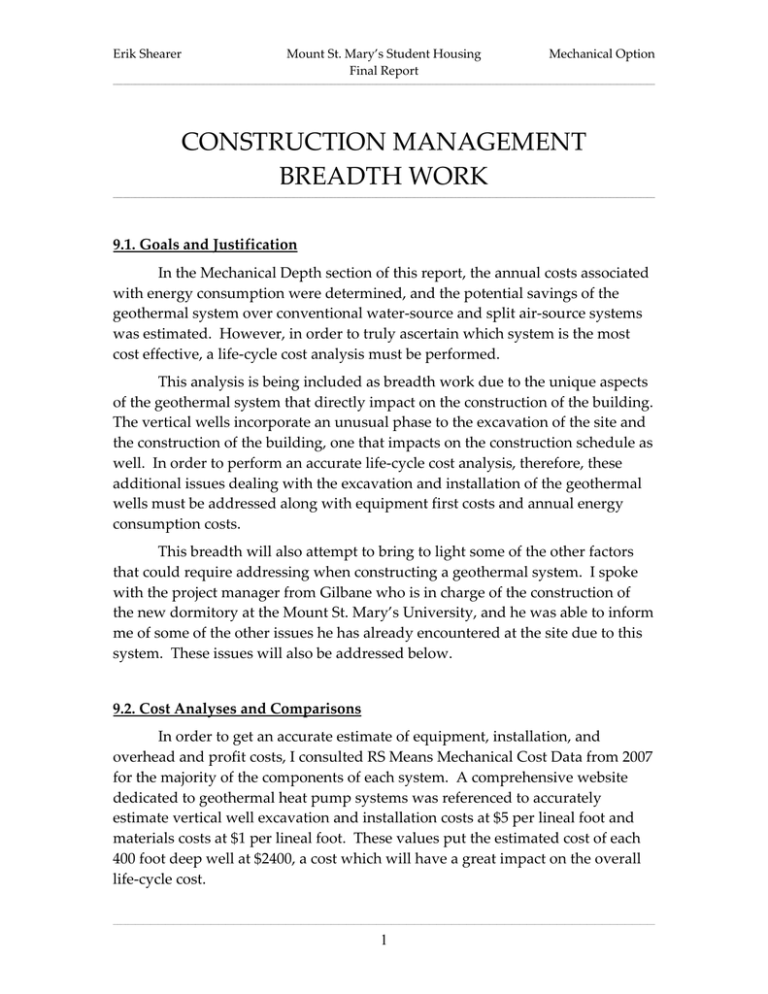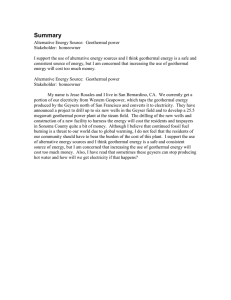CONSTRUCTION MANAGEMENT BREADTH WORK
advertisement

Erik Shearer Mount St. Mary’s Student Housing Final Report Mechanical Option ________________________________________________________________________________________________________________________________________________________________________________________________________________________ CONSTRUCTION MANAGEMENT BREADTH WORK ________________________________________________________________________________________________________________________________________________________________________________________________________________________ 9.1. Goals and Justification In the Mechanical Depth section of this report, the annual costs associated with energy consumption were determined, and the potential savings of the geothermal system over conventional water‐source and split air‐source systems was estimated. However, in order to truly ascertain which system is the most cost effective, a life‐cycle cost analysis must be performed. This analysis is being included as breadth work due to the unique aspects of the geothermal system that directly impact on the construction of the building. The vertical wells incorporate an unusual phase to the excavation of the site and the construction of the building, one that impacts on the construction schedule as well. In order to perform an accurate life‐cycle cost analysis, therefore, these additional issues dealing with the excavation and installation of the geothermal wells must be addressed along with equipment first costs and annual energy consumption costs. This breadth will also attempt to bring to light some of the other factors that could require addressing when constructing a geothermal system. I spoke with the project manager from Gilbane who is in charge of the construction of the new dormitory at the Mount St. Mary’s University, and he was able to inform me of some of the other issues he has already encountered at the site due to this system. These issues will also be addressed below. 9.2. Cost Analyses and Comparisons In order to get an accurate estimate of equipment, installation, and overhead and profit costs, I consulted RS Means Mechanical Cost Data from 2007 for the majority of the components of each system. A comprehensive website dedicated to geothermal heat pump systems was referenced to accurately estimate vertical well excavation and installation costs at $5 per lineal foot and materials costs at $1 per lineal foot. These values put the estimated cost of each 400 foot deep well at $2400, a cost which will have a great impact on the overall life‐cycle cost. ________________________________________________________________________________________________________________________________________________________________________________________________________________________ 1 Erik Shearer Mount St. Mary’s Student Housing Final Report Mechanical Option ________________________________________________________________________________________________________________________________________________________________________________________________________________________ A complete listing of system components and costs can be seen in Appendix G, but Table 9.2.1 below shows an abbreviated listing of the first costs associated with each of the systems. Table 9.2.1: System First Costs Based on the information listed above, it is immediately recognizable that the geothermal system has a far greater installed first cost than the other two systems. This can be attributed directly to the installation costs associated with the vertical wells, causing the installation costs of the geothermal system to be almost four times those of the air‐source system and five times those of the water‐source system. Equipment costs of the ground‐source system are actually less than those of the water‐source system because of the lack of a boiler and cooling tower, and the air‐source system proves to have the least equipment costs because it does not need condenser water pumps either. Coupling the above first costs with the annual energy consumption costs earlier computed using HAP, the life‐cycle costs of each system can be seen in Table 9.2.2 below. A 25 year system life was used, and the discount rate was estimated at 5%. Table 9.2.2: System Life‐cycle Costs Based on this analysis, the geothermal heat pump system does prove that it has the potential to be the most cost effective solution on this project over time. ________________________________________________________________________________________________________________________________________________________________________________________________________________________ 2 Erik Shearer Mount St. Mary’s Student Housing Final Report Mechanical Option ________________________________________________________________________________________________________________________________________________________________________________________________________________________ The system here is projected to save almost $17,000 over conventional water‐ source and almost $28,000 over air‐source in a time period of 25 years. However, the initial first costs of the system proved to be a large hurdle to overcome. It took roughly 17.5 years for the savings of the system to initially overtake air‐ source and another 1.7 years to surpass water‐source. Should the building in question have been something other than a dormitory with a much shorter life span, the savings possible with geothermal would never been seen. Also, there are other considerations that must be addressed with a geothermal system that could have been taken into account in an even more in‐ depth analysis. The project manager in charge of seeing this dormitory built told me that the scheduling and coordination on this project has been somewhat more difficult than on more conventional systems. At present, at least one water line, and perhaps additional underground utility lines, needs to be rerouted in order to install the geothermal system. An additional issue involves the installation of the wells themselves. Because there was a concern that driving heavy machinery over the finished wells might damage their integrity, the excavation for the 64 vertical loops can not even commence until the framing for the building has been entirely completed. Once begun, he estimated that his team should be able to complete the exterior installation of the geothermal system in four to five weeks, averaging a mere two wells per day. Then he would need an additional three weeks for piping and connecting the system to the heat pumps. A complete schedule for HVAC equipment is provided in Appendix H of this report. Because this installation has been pushed back so far, the project may take longer to complete than a more conventional system would, and temporary heating or cooling equipment may need to be brought in and set up at an additional cost in order to allow the laborers to work during certain periods of the year. These additional matters would have needed to at least be considered when selecting the correct system for this building. Still, since the geothermal system requires far less maintenance than the other two systems and should be operational much longer than the 25 years used in this study, the system will continue to provide great savings year after year. ________________________________________________________________________________________________________________________________________________________________________________________________________________________ 3





